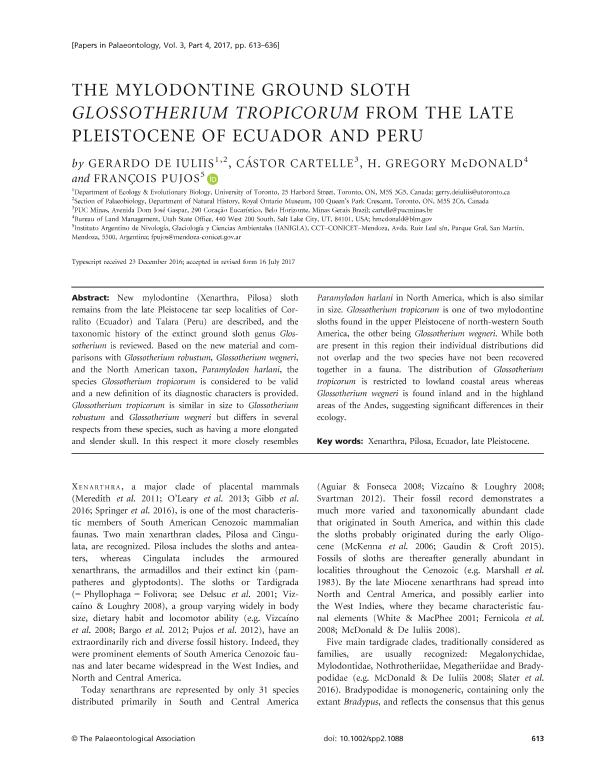Mostrar el registro sencillo del ítem
dc.contributor.author
De Iuliis, Gerardo
dc.contributor.author
Cartelle, Cástor
dc.contributor.author
McDonald, H. Gregory
dc.contributor.author
Pujos, François Roger Francis

dc.date.available
2018-11-09T19:18:48Z
dc.date.issued
2017-11
dc.identifier.citation
De Iuliis, Gerardo; Cartelle, Cástor; McDonald, H. Gregory; Pujos, François Roger Francis; The mylodontine ground sloth Glossotherium tropicorum from the late Pleistocene of Ecuador and Peru; Wiley Blackwell Publishing, Inc; Papers in Palaeontology; 3; 4; 11-2017; 613-636
dc.identifier.issn
2056-2802
dc.identifier.uri
http://hdl.handle.net/11336/64132
dc.description.abstract
New mylodontine (Xenarthra, Pilosa) sloth remains from the late Pleistocene tar seep localities of Corralito (Ecuador) and Talara (Peru) are described, and the taxonomic history of the extinct ground sloth genus Glossotherium is reviewed. Based on the new material and comparisons with Glossotherium robustum, Glossotherium wegneri, and the North American taxon, Paramylodon harlani, the species Glossotherium tropicorum is considered to be valid and a new definition of its diagnostic characters is provided. Glossotherium tropicorum is similar in size to Glossotherium robustum and Glossotherium wegneri but differs in several respects from these species, such as having a more elongated and slender skull. In this respect it more closely resembles Paramylodon harlani in North America, which is also similar in size. Glossotherium tropicorum is one of two mylodontine sloths found in the upper Pleistocene of north-western South America, the other being Glossotherium wegneri. While both are present in this region their individual distributions did not overlap and the two species have not been recovered together in a fauna. The distribution of Glossotherium tropicorum is restricted to lowland coastal areas whereas Glossotherium wegneri is found inland and in the highland areas of the Andes, suggesting significant differences in their ecology.
dc.format
application/pdf
dc.language.iso
eng
dc.publisher
Wiley Blackwell Publishing, Inc

dc.rights
info:eu-repo/semantics/openAccess
dc.rights.uri
https://creativecommons.org/licenses/by-nc-sa/2.5/ar/
dc.subject
Ecuador
dc.subject
Late Pleistocene
dc.subject
Pilosa
dc.subject
Xenarthra
dc.subject.classification
Paleontología

dc.subject.classification
Ciencias de la Tierra y relacionadas con el Medio Ambiente

dc.subject.classification
CIENCIAS NATURALES Y EXACTAS

dc.title
The mylodontine ground sloth Glossotherium tropicorum from the late Pleistocene of Ecuador and Peru
dc.type
info:eu-repo/semantics/article
dc.type
info:ar-repo/semantics/artículo
dc.type
info:eu-repo/semantics/publishedVersion
dc.date.updated
2018-10-23T14:43:46Z
dc.journal.volume
3
dc.journal.number
4
dc.journal.pagination
613-636
dc.journal.pais
Reino Unido

dc.journal.ciudad
Londres
dc.description.fil
Fil: De Iuliis, Gerardo. University of Toronto; Canadá. Royal Ontario Museum; Canadá
dc.description.fil
Fil: Cartelle, Cástor. PUC Minas; Brasil
dc.description.fil
Fil: McDonald, H. Gregory. Utah State Office; Eslovaquia
dc.description.fil
Fil: Pujos, François Roger Francis. Consejo Nacional de Investigaciones Científicas y Técnicas. Centro Científico Tecnológico Conicet - Mendoza. Instituto Argentino de Nivología, Glaciología y Ciencias Ambientales. Provincia de Mendoza. Instituto Argentino de Nivología, Glaciología y Ciencias Ambientales. Universidad Nacional de Cuyo. Instituto Argentino de Nivología, Glaciología y Ciencias Ambientales; Argentina
dc.journal.title
Papers in Palaeontology

dc.relation.alternativeid
info:eu-repo/semantics/altIdentifier/doi/https://dx.doi.org/10.1002/spp2.1088
dc.relation.alternativeid
info:eu-repo/semantics/altIdentifier/url/https://onlinelibrary.wiley.com/doi/abs/10.1002/spp2.1088
Archivos asociados
